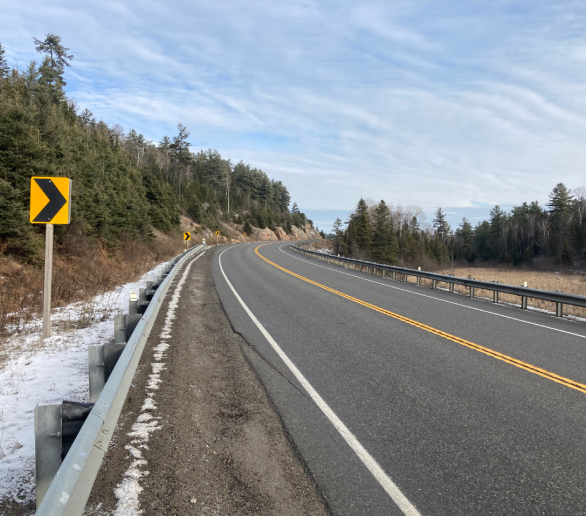Questions & Answers
Question: What is a 2+1 Highway?
Answer: The design involves a three-lane configuration, where passing lanes will alternate every few kilometers within the Project limits for each direction. This design allows for more frequent passing opportunities without widening the highway to four lanes (i.e., two dedicated lanes in each direction at all times). Safety features frequently include the installation of a median barrier and enhanced signing.
A video rendering showing how this design will function has been developed. You can view it here

Question: What is the Project Background?
Answer: In 2018, MTO conducted a feasibility study regarding the implementation of the 2+1 roadway concept as part of an Operational Performance Review (OPR) for a section of Highway 11 between North Bay and Temiskaming Shores. This study revealed concerns related to the type of median barrier typically used, as well as conflicts between design parameters and standards of international jurisdictions that have used 2+1 roadway models, and MTO design standards and parameters, at that time.
In 2020, MTO developed a 2+1 Advancement Working Group to further research 2+1 roadway models and to develop a variation of the model appropriate for Ontario highways. The 2+1 Working Group reviewed and considered three to five candidate locations within each Ministry delivery office area (West, Central, Eastern, Northeastern, Northwestern). Results of this Work Group were documented in a “Site Selection and Design Parameters Report”, which underwent public review and comment (December 14, 2021 to January 14, 2022). The decision was posted February 8, 2022, and is available here: 2+1 Roadway Pilot Project, Site Selection and Design Parameters Report
The Detail Design and Environmental Assessment study for the 2+1 Pilot on Highway 11 north of North Bay was initiated July 18, 2023. AECOM Canada Limited (AECOM) has been retained by the Ministry of Transportation to undertake the Detail Design and Environmental Assessment study for the Project. The Study includes opportunities for public consultation (Public Information Centre, project website), Indigenous Community consultation and engagement, and consultation with local municipalities, regulatory agencies and key stakeholders. The Study will be documented in a Transportation Environmental Study Report, which will be made available for public review on the project website.
Question: Have Indigenous Communities been involved the Project?
Answer: The Ministry of Transportation, as the Crown, has a legal obligation to consult with Aboriginal Peoples. They are committed to meeting its duty to consult with First Nations and Métis communities. Consultations with First Nations and Métis communities will be on-going throughout the Study.
Question: Have Municipal staff been involved in the Project?
Answer: Consultation with municipalities within the Study area will be on-going throughout the Study.
Contact List Registration
We want to hear from you! Your input is important to us. To be added to the Project Contact List or to send your comments to the Project Team, please enter your email below.